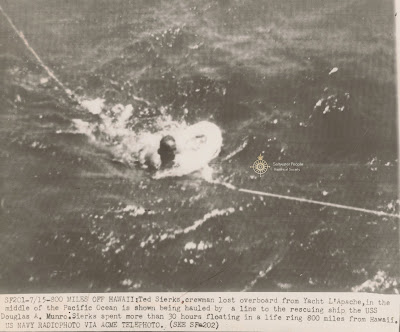 |
SCHOONER GRACIE S sails in the Royal Entourage to open Seattle Seafair Photo dated 11 August 1950 from the archives of the Saltwater People Log© |
King Neptune takes over Seattle: Victor Rabel, as King Neptune I led his royal entourage ashore at the Harbor Patrol dock at the foot of Washington Street to officially open Seattle's first annual Seafair.
Mayor William Devin welcomed the Seafair ruler and his party. The group included: Prime Minister Ray L. Eckmann, a company of guards, and 25 princesses, contenders for Seafair Queen. The royalty arrived on the schooner GRACIE S, under full sail. King Neptune was crowned last night at the Green Lake Aquatheater.
Text from The Seattle Times, 12 August 1950. Front page.
Mayor William Devin welcomed the Seafair ruler and his party. The group included: Prime Minister Ray L. Eckmann, a company of guards, and 25 princesses, contenders for Seafair Queen. The royalty arrived on the schooner GRACIE S, under full sail. King Neptune was crowned last night at the Green Lake Aquatheater.
Text from The Seattle Times, 12 August 1950. Front page.
1950
1952
1952
1955
 |
British Cruiser SUPERB, Pier 91, Seattle, WA. Original photo dated 1955 from the archives of the S.P.H.S. |
Visitors streamed aboard the British cruiser at Pier 91 that year as the SUPERB and 12 ships of the USN were opened for Seattle inspection. Another major attraction was the US aircraft carrier MIDWAY. With them on display were the destroyer escorts BRANNON, GILLIGAN, ROMBACH, JOHNSON, NICKEL, GRADY, WELDEN, GOSS and BUTLER with minesweepers REDSTART and DEXTROUS. Crew members were the guides aboard their ships.
Text from the Seattle Times, 31 July 1955.
1964
1965
Army engineers constructed the bridge from the shore of Lake Washington to the official barge near the Stan Sayres Memorial Park, the site where the unlimited hydroplanes would begin the build-up for the Gold Cup.
Long on years but high on Seafair enthusiasm, Joshua Green appeared in a new role as honorary marshal of the Torchlight Parade. Green took to the honor like a duck takes to Lake Washington in parts uncharted by hydroplanes. "Tip top!" Green cried on learning of the choice.
Text from the Seattle Times, 31 July 1955.
1957  |
PAR-LIN 14-ft sloop after 1,000 miles from Sitka, AK to the Seattle Seafair Summer 1957. Original photo from the archives of the Saltwater People Historial Society© |
Two suntanned youths from Alaska got a Seafair welcome in Seattle after completing a 1,000-mile trip from Sitka.
The sailors were directed to the pier by Harbor Patrol to receive an official Seafair greeting.
Sailors Don Noreen, 18, and Lester Radach, 19, steered their small craft to Pier 50 after a trip from Everett. The boys, who started their trip on 9 June at Stika, also were greeted by Noreen's grandfather, Adam Fries of Tacoma, and other relatives.
The men made most of the journey by sail, but used a borrowed outboard motor for the last leg of the trip; they plan to sell the boat.
The daily distances varied from four to 75 miles; they only experienced minor sailing difficulties.
Abridged text from the Seattle Times 31 July 1957.
1965
 |
Army engineers push a section towards the bridge already installed. Photo date verso, 29 July 1965. Original photo from the archives of the S.P.H.S.© |
Army engineers constructed the bridge from the shore of Lake Washington to the official barge near the Stan Sayres Memorial Park, the site where the unlimited hydroplanes would begin the build-up for the Gold Cup.
1967
 |
Honorary Marshal Mr. Joshua Green (c. 1870-1975) SeaFair, Seattle, WA. 1967. Original photo from the archives of S.P.H.S.© |
Promptly, Green slipped into a Seafair Commodores' jacket, temporarily discarded his hard-brim sailor straw in favor of a Commodore cap and saluted Seafair and all Seattle in his new role.
Honorary chairman of the board of Peoples National Bank of Washington, a golfer, a pheasant-and-duck hunter, a brisk man for all his 97 years. Green said of his appointment:
"It fits me like the paper on the wall. It's a very nice thing, but I don't think I rate it. My steamboating days make me just right for this Seafair job––right out of my Seafair book. Great cities have great festivals––New Orleans has its Mardi Gras, and Seattle has its Seafair. My steamboating fits me for Seafair; my banking fits me for Seafair, for it pours money into the city at this season, and that makes for more prosperity.
Green saluted in front of the Neal Ordayne portrait of him that hangs in the Green home. He grinned as he struck a pose for the new role.
"Reckless abandon," Green said impishly.
Above text by Robert Heilman for the Seattle Times, 31 July 1967
1986





















